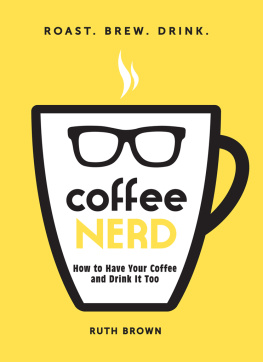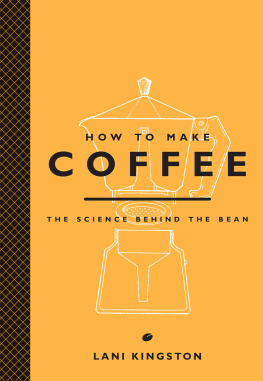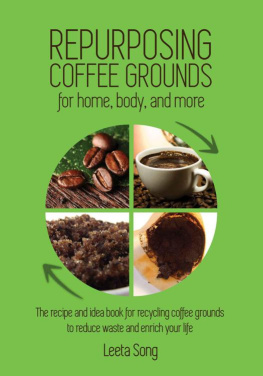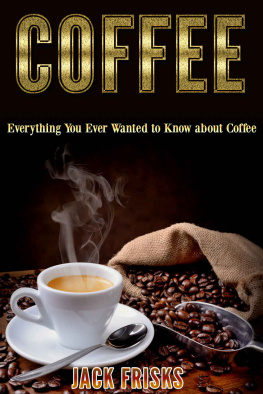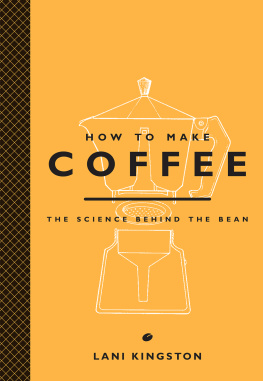Black as the devil, hot as hell, pure as an angel, sweet as love. Thats the recipe for coffee.
Charles Maurice de Talleyrand, nineteenth-century French diplomat
When it comes to coffee, Im a late adopter. While my college fraternity brothers tossed back herculean quantities during late-night study sessions, I didnt touch the stuff. As an army officer, while members of my platoon sucked down coffee with reckless abandon, I remained an outlier. When I managed political campaigns and coffee was the jet fuel of marathon strategy sessions, I passed. At post-church coffee hour, while everyone drank coffee and critiqued the pastors sermon, I drank lemonade.
Miraculously, I also endured a coffee-drinking wife, seminary, and one child without drinking coffee. The combination of two children under the age of two and full-time work in parish ministry, however, put me over the edge. And once I slipped down the rabbit hole of coffee consumption, a journey of discovery emerged that continues to unfold.
Coffee Narratives
Coffee often evokes the power of connection through personal narrative. Ask anyone when they first discovered the joys of coffee and prepare to be regaled with glimpses into their life story. Coffee can serve as an entry point into interpersonal relationships and shed light upon a persons values and most deeply held beliefs. In answering the simple question When did you become a coffee drinker? a person shares much of their life journey.
My parents began every day with freshly brewed coffee. In fact, their actions foreshadowed the Starbucks-driven coffee craze, as they ground whole-bean coffee purchased from specialty shops while most of America still scooped it out of giant tin cans. The sound of the grinder and the irresistible aroma of coffee in my own kitchen always remind me of the comforts and simplicities of childhood.
My late father, a symphony orchestra conductor, had a special relationship with the owner of the local coffee shop in Baltimores Hampden neighborhood. I often accompanied him on his excursions to what was then a rather seedy side of town and is now one of Baltimores hippest areas, chock full of trendy restaurants and coffeehouses.
At The Coffee Mill, a dazzling variety of whole-bean coffees sat in plastic bins with big scoops while the aroma overwhelmed the senses. Customers shoveled beans into bags, then brought them to the counter for weighing. The regulars, mostly men, were a mix of Baltimores intelligentsia, artists, and urban pioneers. It wasnt a cafyou couldnt actually buy a cup of coffeebut no one seemed hurried as they browsed the bins and chatted with fellow patrons.
One year, the owner, seeking a catchy, evocative name for a new blend, gave some beans to my dad to sample, asking him to help christen the roast. Which, I recall with great pride, he did. For many years after we moved from Baltimore to New York, you could still show up at The Coffee Mill and pick up a bag of Allegro con Brio.
Allegro, an Italian word, indicates a brisk or lively tempo in musical scores. Con brio is another musical direction meaning with vigor. So I can only imagine the newly christened coffee was bright, lively, and strong. Too bad I never got to taste it before The Coffee Mill closed down, after nearly three decades, in 2003.
Im not sure why my parents never offered me a taste of their beloved coffee. I mean, they were pretty liberal about letting me and my brother try new things. My mother, a gourmet cook who authored a great little book called The Desperate Gourmet in the mid-1980s, regularly experimented with different styles of food that ended up on our dinner table. My dad even offered me a sip of his beer every now and then, but never coffee. Odd, now that I think about it, especially that I never even asked.
My first taste of coffee came after a fancy dinner at our neighbors house on Englewood Road. The Steinschneiders, an older couple with grown children, occasionally invited our young family over to sit in the dining room for a meal. Mrs. Steinschneider made a big fuss over the after-dinner coffee, and I remember drinking a bit, loaded with milk and sugar, in a china cup.
I didnt drink coffee again until I sidled up to the coffee pot one morning as a desperate, newly ordained cleric at Old St. Pauls Church in downtown Baltimore, dumping in an embarrassing amount of sugar and cream. Basically, and Im being honest and vulnerable here, my first foray into regular coffee drinking was an experience in warm coffee ice cream. As someone who now drinks his coffee the way he wears his clergy shirtsblackthis admission is embarrassing.
Its not as if Im addicted now or anything. Really. I just cant imagine getting the day kick-started without a mug of good coffee. Or making it through the afternoon for that matter.

Mike and Alicia Love at Coffee Labs Roasters in Tarrytown, NY.
Discovering the Good Stuff
Discovering Coffee Labs Roasters in Tarrytown, New York, sent me down the road to coffee snobbery. We lived in a neighboring town for seven years when I served All Saints Church in Briarcliff Manor, about twenty miles up the Hudson River from New York City.
Not only did Coffee Labs roast all their own beans on site (so you left smelling great), not only did they offer free Wi-Fi (rare in those days), not only did they give free refills (exceedingly rare now), they were also dog-friendly. For years I brought Delilah, our rescued yellow lab/husky mix, with me every Thursday morning as I wrote my sermon. Delilah would hang out with her best friend, a pug named Petunia, and Id get down to business.
Granted, I was still drinking flavored coffee doctored up with cream and sugar (French vanilla!), but at least I was getting a taste of coffeehouse culture.
What finally cured me of flavored coffee was actually a physical that suggested I had slightly elevated cholesterol. This struck me as odd since I was running marathons back then and didnt eat, say, a stick of butter for breakfast. My solution revolved around getting rid of the cream. Thus: black coffee.
This epiphany coincided with a ten-day church retreat to a conference center in Mississippi. And it was there, in the rural Deep South, that I made the shift. I forced myself to drink that Mississippi mud, and by the time I came back home to real coffee, my cure had taken effect. Suddenly the flavors of the actual coffee burst through, and I realized what I had been missing all those years. Plus, I always had the nagging feeling the hip, tattooed and pierced baristas were quietly judging me and my flavored coffee as I doctored it up at the fixins bar.


